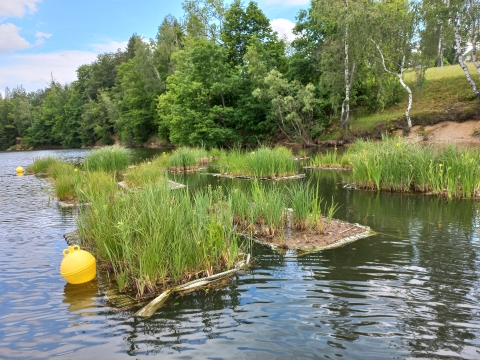Floating islands and booms improve the health of water bodies, provide important habitats for wildlife and have a number of practical water management uses.
Floating reed systems can help reduce nutrient load, partition bodies of water, fight erosion and provide nesting habitats for birds. They also have a significant aesthetic function.

Floating vegetation islands help to reduce the nutrient load of a reservoir. The root systems of reed islands draw nutrients from the water, allowing their vegetation to flourish over the course of the growing season. The reeds are then mowed and composted outside the water body once or twice per year. The islands are essentially floating water treatment plants. At the same time, their root systems provide shelter for propagating zooplankton and smaller fish.
Steep slopes at the bottom of a reservoir reduce the size of the littoral zone, which is an important area that supports a reservoir’s self-cleaning capabilities. The use of floating reed islands expands the littoral zone and creates substitute habitats. At the same time, floating vegetation islands shade the water surface, thus limiting photosynthesis in the water column and slowing heating. Last but not least, the islands have an undeniable aesthetic function.
Floating vegetation booms can perform a variety of functions on water bodies and watercourses. They are a suitable aesthetic revival of vertical bank walls , for example, in the beds of modified watercourses in cities, on embankment walls, in canals, in ports or in retention tanks. At the same time, their presence reduces the erosional effects of waves on the banks of watercourses.
Floating vegetation walls can also be used to partition bodies of water. They can, for example, demarcate swimming areas in recreational ponds, cordon off parts of a lake or prevent the movement of boats. On large bodies of water, floating walls can separate smaller sections and create protective habitats for waterfowl. It is also possible to add a hanging tarpaulin to the wall and use it at the inlet to a body of water to catch floating pollution, sediments and oils.
With their numerous beneficial properties, vegetation walls are suitable for a wide range of environments: watercourses, recreational ponds, lakes, retention tanks, ornamental parks and zoos.
Related Products:
Areas of Application:
Floating islands devoid of vegetation are a popular habitat and nesting site for a variety of waterfowl. Especially on large bodies of water and reservoirs, these artificial habitats provide a safe haven and promote biodiversity. Floating gravel islands are assembled from triangular segments of different sizes, and they can also be combined with floating vegetation islands.
Floating islands without vegetation can also be used as breeding rafts or as carriers for technical equipment such as solar cells or aeration pumps.
Related Products:
ArmaFlor non-floating reed rollers are cultivated vegetation elements that can be used for fast, effective and aesthetically pleasing reinforcement of eroded banks without the need for complicated foundations.